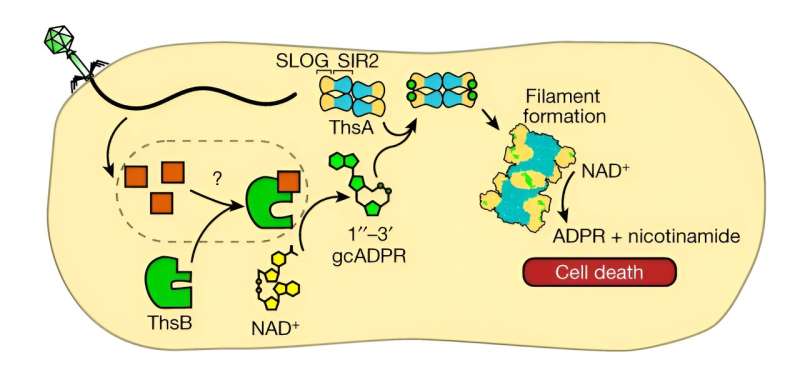This article has been reviewed according to Science X's editorial process and policies. Editors have highlighted the following attributes while ensuring the content's credibility:
fact-checked
peer-reviewed publication
trusted source
proofread
New research reveals activation mechanism of Thoeris antiviral defense system

Senior Researcher Dr. Giedrė Tamulaitienė and colleagues from Vilnius University Life Sciences Center (VU LSC), in collaboration with the researchers from Weizmann Institute of Sciences (Israel), revealed an activation mechanism of the Thoeris antiviral defense system effector.
The article, "Activation of Thoeris antiviral system via SIR2 effector filament assembly," was published in Nature. Scientists have determined the structure of the previously unknown active SIR2 effector of the bacterial defense system Thoeris (named after the Egyptian goddess who protects childbirth and fertility) and proposed an activation mechanism.
In addition to the well-known gene and genome scissors—restriction-modification and CRISPR-Cas systems—more than 100 different bacterial antiviral defense systems have been discovered. A group of scientists led by Dr. G. Tamulaitienė is studying the Thoeris bacterial defense system that consists of the TIR protein sensor and SIR2 effector protein.
When the TIR sensor protein senses a viral infection, it sends a message—and synthesizes a unique small molecule called gcADPR. This messenger molecule is recognized by another protein of the Thoeris system, the effector SIR2 protein, which begins to degrade the molecule cofactor NAD, which is essential for the survival and reproduction of bacteria.
In this way, the infected bacterium surrenders—it dies before the virus can replicate, but this gives neighboring bacteria the ability to survive, thus preserving their population.
Until now, it was not known how the Thoeris effector reads the message and turns on its activity. Using cryogenic electron microscopy, scientists at Vilnius University determined the structure of the active effector and showed that, when it binds the molecule produced by the sensor, the SIR2 effector forms a long polymer–helical filament. The filament structure stabilizes the active center of the effector and ensures effective degradation of the NAD molecule.
"Some other bacterial antiviral systems also form filaments, but their biological significance was unknown until now. We have shown that filament formation helps to ensure a switch-like response: only when a certain level of virus signal is reached, the effector activity is switched on, and leads to bacterial death," says Dr. G. Tamulaitienė.
More information: Giedre Tamulaitiene et al, Activation of Thoeris antiviral system via SIR2 effector filament assembly, Nature (2024). DOI: 10.1038/s41586-024-07092-x
Journal information: Nature
Provided by Vilnius University




















